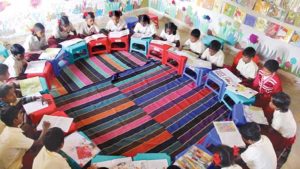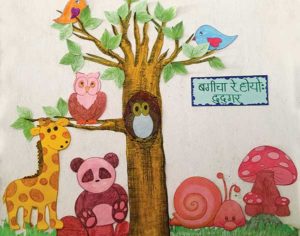Divya Tirkey
“We must acknowledge that reading and writing are cultural practices and if they are absent in a culture, then we are obligated to include them in the most graceful and positive way we can. Enter-the Library!” (Noronha, 2014). I came across this statement while reading an article by Sujata Noronha while I was enrolled in an English Library Educator’s Course (LEC) in 2017. Constant reflection on this statement made me imbibe the lesson and led me to incorporate it into a tangible action plan. The results have been remarkable with development of either library corners or separate library rooms and initiation of library sessions in most of the schools in Khunti1.
 Though the Right to Education mandates that every school should have a library, we rarely saw libraries in the schools of Khunti. NCF 2005 also states that in the future, India must move towards equipping every school, irrespective of its level, with a library. Further it states that the library period should be devoted to reading. But sadly, schools here had no libraries and even if they did library periods were not incorporated in the school timetable. In a majority of schools, books were kept in closed cupboards. The teachers were hesitant to give out the books for fear of losing them.
Though the Right to Education mandates that every school should have a library, we rarely saw libraries in the schools of Khunti. NCF 2005 also states that in the future, India must move towards equipping every school, irrespective of its level, with a library. Further it states that the library period should be devoted to reading. But sadly, schools here had no libraries and even if they did library periods were not incorporated in the school timetable. In a majority of schools, books were kept in closed cupboards. The teachers were hesitant to give out the books for fear of losing them.
Besides non-availability of libraries and books, a culture of silence prevails among the Munda tribal children. They rarely speak or speak with much prompting. Belonging to the marginalized sections of the society they are also hit by literacy blocks. “Educationists have long made claims that literacy is best supported by stimulating young learners with print, talk, and opportunities to express oneself in both speech and writing (Noronha, 2014).” Library books are one source, which I felt, should be optimally used to help children gain wide exposure to language and also to a world they are unaware of. To help them come out of the culture of silence was also of utmost importance to me, and I believed that library books were the best resource.
Bringing the above ideas into action was not easy. The image of a library that the teachers and my team members could recall was that of books stacked in cupboards or rooms with little or no access to the readers except the librarians. This image of a library was shared by government school teachers as well as our team. I too had a similar image of a library until I joined LEC and learnt what a children’s library could look like and how it can function.
Convincing the teachers to help develop a vibrant library was difficult. Discussions were not helping. Along with my team members, I developed a few children’s libraries using locally available resources and with some investment on books and sitting arrangements. We convinced the teachers of the importance of having libraries and incorporated a library period in the school routine. We conducted library sessions and activities like read aloud, dumb charades, storytelling, etc. These activities attracted the children towards books. The number of children taking and reading books increased day by day and it was great to know that the children had read almost all the books we had made available to them. The children, who were still developing their reading skills, started handling books, ‘reading’ pictures and discussing among themselves.
 These experiences with evidences were shared with other teachers. Even exposure visits helped. Some of the teachers took the initiative to develop libraries on their own and incorporate library periods in the school timetable. The results were amazing. Today the library period is incorporated in almost all the schools2 we are working with and either library corners or library rooms have been developed.
These experiences with evidences were shared with other teachers. Even exposure visits helped. Some of the teachers took the initiative to develop libraries on their own and incorporate library periods in the school timetable. The results were amazing. Today the library period is incorporated in almost all the schools2 we are working with and either library corners or library rooms have been developed.
Community participation was another aspect we had focussed on while working on the libraries. This was to make them aware of the importance of education and to ensure their support in providing quality education to children. Discussions were held with the community and support was sought from them in any form they could for developing the libraries. They came up with ideas like cleaning the rooms, making decorative items, book shelves using bamboo, book bags made out of gunny bags and making modhas (stool) for sitting. This idea of community participation was put into practice across schools and it bore fruit. The community members were quite excited and felt proud that they helped children develop libraries. We are also trying to motivate the community to buy books for their children. It is ensured that School Management Committee (SMC) members during meetings tell stories to children. On the other hand, students are motivated to take books for their parents or siblings and read aloud to them.
The learning at Library Educator’s Course supported by Parag Initiative of the Tata Trusts not only helped me widen my understanding of children’s libraries but also helped in taking innovative ideas to the children in the remotest areas of Khunti District.
It is a challenge now for us to make available more books to these children. However we are happy that we have been able to develop a reading culture, which was earlier absent – we have entered the library!
For more details on Library Educator’s Course, go to http://paragreads.in.
References
• Noronha, Sujata (2014), Why a Library Program in Schools and the Community
• Right to Education Act 2009
• National Curriculum Framework, 2005
The author is a Programme Coordinator with Collectives for Integrated Livelihood Initiatives (CInI) Tata Trusts. She can be reached at dtirkey@tatatrusts.org, divyajyotitirkey@gmail.com.
